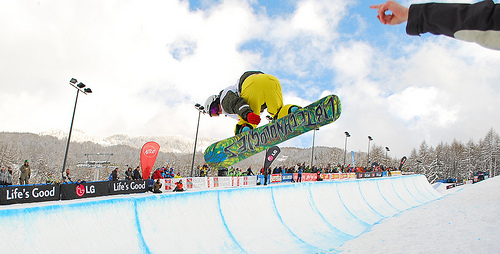Guest blog by @CarolineFinch
 In the recent BJSM blog Is high level snowboard too dangerous to allow your children to participate? Prof Engebretsen raises an important question, namely how to prevent injuries in a sport where pushing the extremes of physical performance in challenging and harsh environments is both an individual athlete and sporting organisation goal.[1]
In the recent BJSM blog Is high level snowboard too dangerous to allow your children to participate? Prof Engebretsen raises an important question, namely how to prevent injuries in a sport where pushing the extremes of physical performance in challenging and harsh environments is both an individual athlete and sporting organisation goal.[1]
Most recent advances in sports injury prevention have tended to focus directly on the athletes, themselves, with the aim of making them more resilient to the injury risks they are faced with in their chosen sport. I wonder if, for sports such as snowboarding where most injuries result from acute energy exchange beyond the body’s tolerance, it is time to go back to first principles for injury prevention and revisit the application of Haddon’s 10 countermeasure strategies.[2] In this hierarchy of injury control, “Make what is to be protected more resistant to damage from the hazard” is only the eighth strategy. There are seven higher order control strategies that could (and should) be applied to also reduce injury risks and hazards.
Engebretsen [1]also queries whether leaders of the sport really have true awareness of the risks in elite snowboarding. The fact that so little ongoing attention seems to have been given to identifying and implementing solutions meeting many of the higher-order Haddon countermeasure strategies would seem to support this. Interestingly, a recent blog by Laura Robinson at playthegame.org also queries whether “sports officials’ tendencies to put the fight for new viewers by making the sports more dangerous and exciting” are more favoured than the safety of the athletes of snow sports.[3]
We published a review of the evidence for preventing snowboarding injuries in 1999, with the main focus on recreational participants of this sport as it was still a very new activity in Australia.[4] At that time, the sport was considered similar to other snow sports and so most safety advice was derived from that for more general snow/ski safety. One of our conclusions was:
“the rapid international growth of the sport has not been matched by a detailed epidemiological evaluation of the injuries specific to snowboarding or of the countermeasures to prevent them” (page 118).
It would seem that the situation has not changed that much. All sports injuries occur within an ecological context in which multiple levels of the sports delivery system interact with the physical environments in which sports are undertaken and the specific characteristics of the athletes who participate in them.[5] This applies equally well to high performance and professional sport as it does to the more recreational forms. Future safety gains for snowboarding, as indeed other sports, will only be achieved if all stakeholder groups:
- are engaged and united from the outset;
- share common goals for the ongoing development of the sport;
- prioritise the safety of their athletes; and
- jointly invest in the development, implementation and evaluation of cost-effective injury prevention solutions according to Haddon’s hierarchy of control as translated to this sport.
References
2. Haddon WJ. Energy damage and the 10 countermeasure strategies. 1973;13:321-31.
3. Robinson L. Faster, Higher … Deader. Posted 23/03/2012. playthegame.org; 2012.
4. Finch C, Kelsall H. Preventing snowboarding injuries – what is the evidence? 1999;6:117-26.
*************************************************************
Caroline Finch is an injury prevention researcher from the Australian Centre for Research into Injury in Sport and its Prevention (ACRISP) within the Monash Injury Research Centre, Monash University, Australia. She specialises in implementation and dissemination science applications for sports injury prevention. She is the Senior Associate Editor for Implementation & Dissemination for the British Journal of Sports Medicine and a member of the Editorial Board of Injury Prevention; both journals are
published by the BMJ Group.
Caroline can be followed on Twitter @CarolineFinch